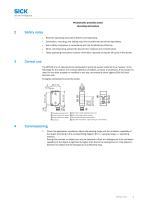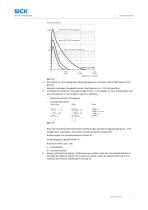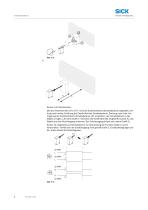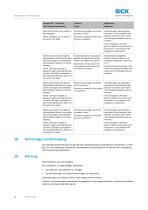
Catalog excerpts

OPERATING INSTRUCTION Miniature photoelectric sensor
Open the catalog to page 1
Sensor Intelligence. Photoelectric proximity sensor Operating instructions Read the operating instructions before commissioning. Connection, mounting, and setting may only be performed by trained specialists. Not a safety component in accordance with the EU Machinery Directive. When commissioning, protect the device from moisture and contamination. These operating instructions contain information required during the life cycle of the sensor. The WT100-2 is an opto-electronic photoelectric proximity sensor (referred to as "sensor" in the following) for the optical, non-contact detection of...
Open the catalog to page 2
Commissioning Function reserve Distance in m (feet) Image 1: H Mount the sensor using a suitable mounting bracket (see the SICK range of accessories). Note the sensor's maximum permissible tightening torque of < 0.5 Nm. The sensors must be connected in a voltage-free state (VS = 0 V). The information in the graphics [B] must be observed, depending on the type of connection: – Male connector connection: pin assignment – Cable: core color Only apply voltage/switch on the power supply (VS > 0 V) once all electrical connections have been completed. The green LED indicator lights up on the...
Open the catalog to page 3
Sensor with potentiometer: The sensitivity (sensing range) is adjusted with the potentiometer (type: 270°). Clockwise rotation: sensitivity (sensing range) increased; counterclockwise rotation: sensitivity (sensing range) reduced. We recommend placing the switching state in the object, e.g., see Graphic F. Once the sensitivity has been adjusted, the object is removed from the path of the beam. The switching output changes (see Graphic C). The sensor is adjusted and ready for operation. Refer to Graphics C and G to check the func‐ tion. If the switching output fails to behave in accordance...
Open the catalog to page 4
Fault diagnosis Table indicates which measures are to be taken if the sensor stops working. Tab_Fault diagnosis LED indicator/fault pattern / Green LED does not light up or flickers / Sensor is still ready for operation, but the operating conditions are not ideal (operating reserve factor between 0.9 and 1.1) / Green LED does not light up or flickers Green LED does not light up / Green LED does not light up Check the operating conditions: Fully align the beam of light (light spot) with the object. / Clean the optical surfaces / Readjust the Sensor is still ready for operation, sensitivity...
Open the catalog to page 5
Yellow LED lights up, no object in the path of the beam / Remission capability of the back‐ ground is excessive / Yellow LED lights up, no object in the path of the beam Remission capability of the back‐ ground is excessive Check changes to the back‐ ground. Reduce the sensitivity of the sensor or use sensors with background suppression / Check changes to the back‐ ground. Reduce the sensitivity of the sensor or use sensors with background suppression Yellow LED does not light up (applies to light switching devices) or yellow LED lights up (applies to dark switching devices), object is in...
Open the catalog to page 6
Sensor Intelligence. Vor der Inbetriebnahme die Betriebsanleitung lesen. Anschluss, Montage und Einstellung nur durch Fachpersonal. Kein Sicherheitsbauteil gemaS EU-Maschinenrichtlinie. Gerat bei Inbetriebnahme vor Feuchte und Verunreinigung schutzen. Diese Betriebsanleitung enthalt Informationen, die wahrend des Lebenszyklus des Sensors Die WT100-2 ist ein optoelektronischer Reflexions-Lichttaster (im Folgenden Sensor genannt) und wird zum optischen, beruhrungslosen Erfassen von Sachen, Tieren und Personen eingesetzt. Bei jeder anderen Verwendung und bei Veranderungen am Produkt verfallt...
Open the catalog to page 7
Inbetriebnahme Function reserve Den Sensor an einen geeigneten Befestigungswinkel montieren (siehe SICK-Zubehör-Pro‐ gramm). Maximal zulässiges Anzugsdrehmoment des Sensors von < 0.5 Nm beachten. Anschluss der Sensoren muss spannungsfrei (VS = 0 V) erfolgen. Je nach Anschlussart sind die Informationen in den Grafiken [vgl. B] zu beachten: – Steckeranschluss: Pinbelegung – Leitung: Adernfarbe Erst nach Anschluss aller elektrischen Verbindungen die Spannungsversorgung (VS > 0 V) anlegen bzw. einschalten. Am Sensor leuchtet die grüne Anzeige-LED. Erläuterungen zum Anschlussschema (Grafik B):...
Open the catalog to page 8
Sensor mit Potentiometer: Mit dem Potentiometer (Art: 270°) wird die Empfindlichkeit (Schaltabstand) eingestellt. Dre‐ hung nach rechts: Erhöhung der Empfindlichkeit (Schaltabstand), Drehung nach links: Ver‐ ringerung der Empfindlichkeit (Schaltabstand). Wir empfehlen, den Schaltabstand in das Objekt zu legen, z.B. siehe Grafik F. Nachdem die Empfindlichkeit eingestellt worden ist, das Objekt aus dem Strahlengang entfernen. Der Schaltausgang ändert sich (siehe Grafik C). Sensor ist eingestellt und betriebsbereit. Zur Überprüfung der Funktion Grafik C und G heranziehen. Verhält sich der...
Open the catalog to page 9
Fehlerdiagnose Tabelle I zeigt, welche Maßnahmen durchzuführen sind, wenn die Funktion des Sensors nicht mehr gegeben ist. Tab_Fehlerdiagnose Anzeige-LED / Fehlerbild / Grüne LED leuchtet nicht bzw. fla‐ ckert / Sensor ist noch betriebsbereit, aber die Betriebsbedingungen sind nicht optimal (Funktionsre‐ servefaktor zwischen 0,9 und 1,1) / Green LED does not light up or flickers grüne LED leuchtet nicht / Green LED does not light up Betriebsbedingungen prüfen: Lichtstrahl (Lichtfleck) vollständig auf das Objekt ausrichten / Reini‐ gung der optischen Flächen / Empfindlichkeit (Potentiometer)...
Open the catalog to page 10
Anzeige-LED / Fehlerbild / gelbe LED leuchtet, kein Objekt im Strahlengang / Remissionsvermögen des Hinter‐ grundes zu hoch / Yellow LED lights up, no object in the path of the beam Remission capability of the back‐ ground is excessive Veränderungen des Hintergrun‐ des prüfen. Empfindlichkeit des Sensors reduzieren oder Taster mit Hintergrundausblendung ver‐ wenden / Check changes to the back‐ ground. Reduce the sensitivity of the sensor or use sensors with background suppression Gelbe LED leuchtet nicht (gilt für hellschaltende Geräte), bzw. gelbe LED leuchtet (gilt für dunkelschal‐ tende...
Open the catalog to page 11All SICK SENSOR INTELLIGENCE catalogs and technical brochures
-
REGISTRATION SENSORS
24 Pages
-
CLV63x, CLV64x, CLV65x
102 Pages
-
WTB16 Bluetooth®
135 Pages
-
WE9LC-3_A71
3 Pages
-
Safety Switches
20 Pages
-
Automation light grids
8 Pages
-
Encoders and Inclination Sensors
32 Pages
-
Proximity Sensors
324 Pages
-
Dust measuring devices
172 Pages
-
Detection and Ranging Solutions
124 Pages
-
Distance Sensors
404 Pages
-
Vision
124 Pages
-
Top-Products from SICK
556 Pages
-
Fluid Sensors
243 Pages
-
Registration Sensors
276 Pages
-
Magnetic Cylinder Sensors
164 Pages
-
IDENTIFICATION SOLUTIONS
24 Pages
-
Our identification solutions
8 Pages
-
FLOWSIC300 Ultrasonic Gas Flow Meter
177 Pages
-
FLOWSIC300 Gas flow meters
12 Pages
-
FLOWSIC500 Gas flow meters
16 Pages
-
FLOWSIC600 Ultrasonic Gas Flow Meter
138 Pages
-
FLOWSIC600 Gas Flow Meter
16 Pages
-
ConVer
12 Pages
-
GM32 In-situ gas analyzers
28 Pages
-
GM35 In-Situ IR Gas Analyzer
16 Pages
-
Encoders
788 Pages
-
Opto Electronic Protective Devices
712 Pages
-
GMS800 Extractive Gas Analyzers
20 Pages
-
VPS Pro Profiling systems
20 Pages
-
Photoelectric Sensors
949 Pages
-
G6 - Global Sensor
20 Pages
-
Hand-Held Scanners IDMx
48 Pages














































